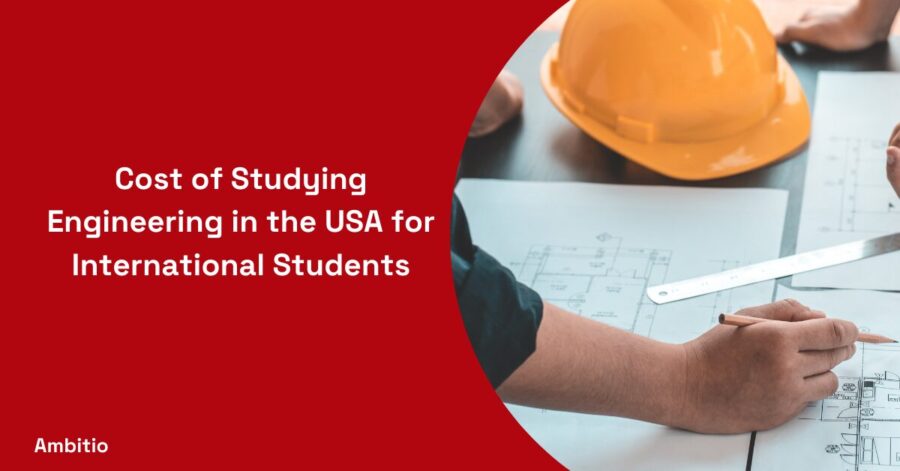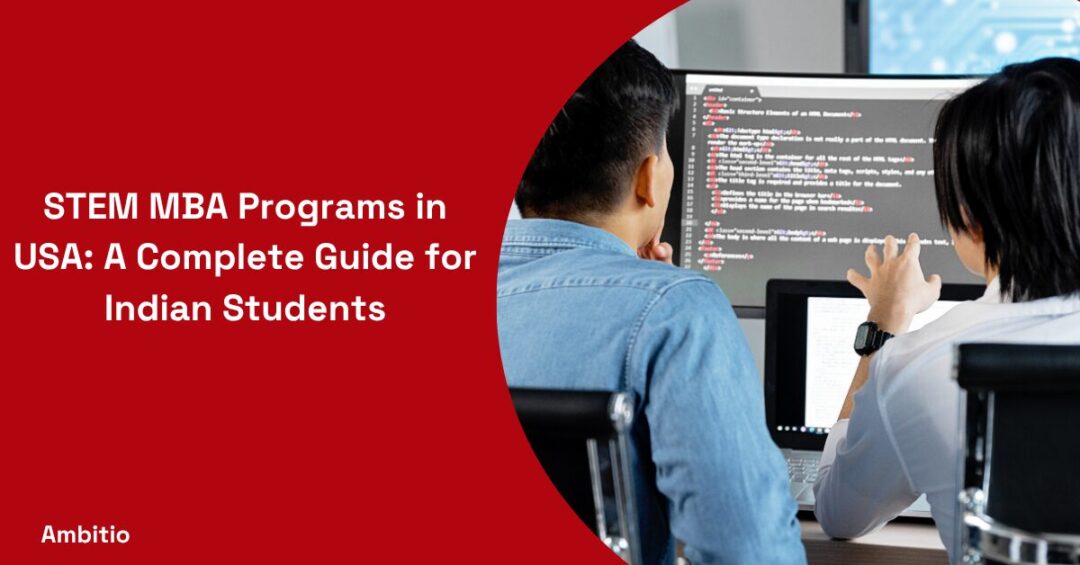12 December 2024
8 minutes read
Cost of Studying Engineering in the USA for International Students

Introduction
Embarking on an educational journey in engineering at a US university is a goal many international students, including those from India, aspire to achieve.
The USA, with its top-tier engineering programs, cutting-edge technology, and research opportunities, makes for an ideal destination. However, the financial aspect of this journey is a critical element that requires thorough understanding and planning.
This blog aims to explore the various facets of the cost of studying engineering in the USA for international students in 2024, offering a detailed insight into budgeting and financial planning.
Understanding the Financial Landscape for International Engineering Students in the USA
Comprehensive Tuition Fee Analysis for Engineering Programs
Breakdown of Tuition Fees Across Top Universities
The cost of tuition is the most substantial expense for international students. Top US universities, known for their elite engineering programs, often have higher tuition fees.
For example, programs like Mechanical, Electrical, and Civil Engineering at esteemed institutions like MIT, Stanford, or UC Berkeley can range significantly.
The tuition fee not only covers the cost of education but also access to state-of-the-art facilities, experienced faculty, and industry connections.
Comparing Public and Private University Fees
The choice between public and private universities significantly affects tuition costs. Public universities, often subsidized by the state, can offer lower tuition fees compared to private institutions.
However, private universities might provide more scholarships and financial aid opportunities. It’s essential for students to weigh the pros and cons of each before making a decision.
Living and Accommodation Costs for Students in Different States
Cost of Living in Major University Cities
The cost of living is a crucial factor that varies greatly across the USA. Cities like Boston, New York, and San Francisco, housing some of the top universities, also rank among the most expensive in terms of living costs.
Housing, food, transportation, and personal expenses must be considered. For instance, the monthly rent for a single-bedroom apartment in these cities can be substantially higher than in less urban areas.
Budgeting Tips for Managing Living Expenses
Effective budgeting is key to managing living costs. Students can explore options like shared apartments, part-time jobs, and cost-effective meal plans.
It’s also beneficial to utilize student discounts available in transportation, shopping, and entertainment in most university towns.
Financial Aid and Scholarship Opportunities for International Students
Pursuing engineering in the USA can be financially challenging for international students. However, a range of financial aid and scholarship opportunities are available to help mitigate these costs. Here’s a breakdown of these opportunities in point form:
- University-Specific Scholarships:
- Many US universities offer scholarships directly to international students.
- These can range from partial to full tuition waivers.
- Some scholarships may also cover living expenses or offer a stipend.
- Departmental Scholarships:
- Engineering departments within universities often have their own scholarships.
- These are usually merit-based and may require a separate application.
- External Scholarships and Fellowships:
- Organizations and foundations outside of universities offer scholarships.
- Examples include the Fulbright Program, the American Society of Mechanical Engineers (ASME) scholarships, and IEEE scholarships.
- Eligibility can be based on nationality, field of study, or academic excellence.
- Government-Sponsored Scholarships:
- Many governments offer scholarships for their citizens to study abroad, including in the USA.
- Examples include the China Scholarship Council and the Indian Government’s National Overseas Scholarship.
- Private and Corporate Scholarships:
- Corporations and private entities sometimes provide scholarships to international students.
- These may be linked to internships or future employment opportunities.
- Need-Based Financial Aid:
- Although less common for international students, some universities offer need-based aid.
- Applicants may need to provide proof of their financial circumstances.
- Research Assistantships and Teaching Assistantships:
- These positions typically provide a tuition waiver and a stipend.
- They involve working a set number of hours per week in research or teaching roles.
- On-Campus Employment:
- International students are allowed to work part-time on campus.
- Income from these jobs can help cover living expenses.
- Graduate Fellowships:
- For graduate students, fellowships offer substantial financial support.
- They usually cover tuition and provide a living stipend.
- Internships and Co-op Programs:
- Internships and cooperative education programs can provide financial benefits.
- These programs integrate academic study with practical work experience.
- Loans for International Students:
- Some US banks and financial institutions offer loans to international students.
- These often require a co-signer who is a US citizen or permanent resident.
- Crowdfunding and Sponsorships:
- Students can also explore crowdfunding platforms or seek sponsorships from businesses or community organizations in their home country.
- Students can also explore crowdfunding platforms or seek sponsorships from businesses or community organizations in their home country.
- Scholarship Search Engines and Resources:
- Websites like Fastweb, EducationUSA, and Chegg Scholarships can help locate scholarships.
- Websites like Fastweb, EducationUSA, and Chegg Scholarships can help locate scholarships.
Remember, deadlines for these scholarships and financial aid options can vary, and early application is often key to securing funding. Additionally, eligibility criteria and the application process can differ significantly, so thorough research and preparation are crucial.
Additional Costs: Books, Supplies, and Personal Expenses
Estimating Academic Supplies and Miscellaneous Costs
Academic supplies, including books, lab equipment, and software licenses, can add a significant amount to the total cost. It’s advisable to budget for these expenses, which can sometimes be overlooked in the planning phase.
Additionally, personal expenses like health insurance, entertainment, and travel should also be factored into the budget.
Visa Application Process and Related Expenses for International Students
Navigating the visa application process and understanding the related expenses are crucial steps for international students planning to study engineering in the USA. Here is a breakdown of the key points in this process:
- Determine the Correct Visa Type:
- Most international students will need an F-1 student visa.
- This visa is specifically for academic students attending a university or college, high school, private elementary school, or language training program.
- Secure Admission and Obtain Form I-20:
- Before applying for a visa, students must be accepted by a Student and Exchange Visitor Program (SEVP)-certified school.
- Upon acceptance, the school will provide Form I-20, which is required for the visa application.
- Pay the SEVIS I-901 Fee:
- Students must pay the SEVIS I-901 fee before applying for a visa.
- The fee supports the system that tracks students and ensures they maintain their visa status.
- Complete the Visa Application (Form DS-160):
- The DS-160 form is the online nonimmigrant visa application form.
- It must be filled out and submitted electronically prior to scheduling a visa interview.
- Schedule and Prepare for the Visa Interview:
- Applicants must schedule an interview with the U.S. embassy or consulate in their home country.
- During the interview, consular officers will determine eligibility for the F-1 visa.
- Visa Application Fee:
- There is a non-refundable visa application fee, also known as the MRV fee.
- The fee amount varies depending on the applicant’s home country.
- Gather Required Documentation:
- Documents typically needed for the visa interview include a passport, Form I-20, DS-160 confirmation page, application fee payment receipt, and photographs.
- Additional documentation may include transcripts, diplomas, test scores, and financial evidence proving the ability to cover expenses in the USA.
- Show Proof of Financial Support:
- Visa applicants must provide evidence of sufficient funds to cover tuition and living expenses.
- This can be in the form of bank statements, affidavits of support, or scholarship letters.
- Health Insurance Requirement:
- While not a prerequisite for the visa itself, many universities require international students to have health insurance.
- Students should factor in the cost of health insurance when estimating their total expenses.
- Travel and Post-Arrival Expenses:
- Students should budget for travel costs to the USA and initial expenses upon arrival, such as housing deposits and basic living supplies.
- Potential for Visa Renewal Costs:
- In cases where students need to extend their stay, they should be aware of the potential costs associated with visa renewal or adjustment.
- In cases where students need to extend their stay, they should be aware of the potential costs associated with visa renewal or adjustment.
- Consideration for Dependent Family Members:
- If students plan to bring dependents (spouses or children), additional applications and fees for F-2 visas are required.
- If students plan to bring dependents (spouses or children), additional applications and fees for F-2 visas are required.
- Seek Guidance from the University’s International Student Office:
- Many universities have offices dedicated to assisting international students with the visa process and can provide valuable guidance and resources.
- Many universities have offices dedicated to assisting international students with the visa process and can provide valuable guidance and resources.
Understanding and preparing for these steps and expenses is essential for a smooth transition to studying in the USA. Early preparation and adherence to visa requirements can greatly facilitate the process.
Career Prospects and Return on Investment Post-Graduation
The decision to study engineering in the USA is not just an academic choice but also a significant financial investment. International students often weigh the cost against the potential return on investment (ROI), which is primarily seen through career prospects post-graduation.
This section explores the job market, salary expectations, and long-term ROI for engineering graduates in the USA.
Job Market Landscape for Engineering Graduates in the USA
The job market in the USA for engineering graduates remains robust and promising. With the country being at the forefront of technological innovation and industrial advancement, engineers are in high demand across various sectors.
This demand is not just limited to traditional fields like civil, mechanical, or electrical engineering but also extends to newer domains like software engineering, biomedical engineering, and environmental engineering.
Career opportunities for engineering graduates are vast, ranging from roles in research and development, design and construction, and project management, to consulting and beyond.
The emergence of fields like artificial intelligence, renewable energy, and cybersecurity has also opened new avenues for employment.
Additionally, engineering graduates are often preferred for roles in technical management and business consulting, owing to their problem-solving skills and analytical thinking.
Salary Expectations for Engineering Graduates in the USA
One of the most compelling reasons for studying engineering in the USA is the lucrative salary packages offered to graduates. According to data from various employment and labor statistics, engineering graduates, especially in fields like software, petroleum, and chemical engineering, command some of the highest starting salaries among all professions.
For instance, software engineers in the US can expect an average starting salary that is significantly higher than many other professions.
It’s important to note that salaries can vary based on factors such as the specific engineering discipline, geographic location, and the individual’s skill set.
However, even at entry-level positions, engineering graduates typically earn above-average salaries compared to other fields.
Long-Term Return on Investment (ROI)
When assessing the ROI of an engineering degree from a US university, it’s essential to look beyond the initial high tuition and living costs. Long-term benefits include not only high earning potential but also career stability and growth opportunities.
Engineering graduates often experience rapid professional growth, with opportunities to move into higher managerial or specialized technical roles, which come with increased earning potential.
Moreover, an engineering degree from a prestigious US university enhances a graduate’s employability on a global scale. The quality of education, hands-on experience, and the network developed during their study in the USA are assets that add to their professional value, making them desirable candidates in the international job market.
Furthermore, the experience and skills gained during their education enable many engineering graduates to venture into entrepreneurship, contributing to innovations and potentially leading to substantial financial success and personal fulfillment.
Non-Financial Returns: Skill Development and Networking
Beyond the monetary aspect, studying engineering in the USA offers non-financial returns that significantly contribute to a graduate’s career and personal development.
The exposure to a diverse cultural environment, cutting-edge technology, and research opportunities foster a broad skill set that goes beyond technical expertise.
Skills in leadership, communication, teamwork, and problem-solving are honed, which are invaluable in any career path.
Additionally, the network that students build during their time in the USA — comprising peers, professors, and industry professionals — can open doors to various opportunities in both the corporate and academic worlds.
This network can be a source of mentorship, career advice, and job referrals, playing a crucial role in a graduate’s professional journey.
Cultural and Social Adaptation Costs for International Students
The Hidden Costs of Adapting to Life in the USA
Adapting to a new cultural and social environment involves hidden costs. This includes expenses related to networking, participating in social activities, and even adapting to a different lifestyle, all of which are crucial for a wholesome educational experience.
Conclusion
Pursuing an engineering degree in the USA as an international student is a significant financial undertaking, encompassing tuition fees, living expenses, and other associated costs.
However, with the right planning, scholarships, and financial management, this investment can lead to unparalleled educational and career opportunities.
The journey of studying engineering in the USA is not just about academic growth but also personal and professional development, making it a worthwhile endeavor for many aspiring international students.
FAQs
Q1: What is the average annual cost, including tuition and living expenses, for studying engineering in the USA?
The average annual cost, including tuition and living expenses, can range significantly based on the university and city. It’s essential to research specific programs and locations for accurate estimates.
Q2: Can international students work while studying in the USA to offset costs?
Yes, international students on F-1 visas are allowed to work part-time on-campus and potentially off-campus with specific authorizations, which can help offset living costs.
Q3: How important is it to consider the cost of living in addition to tuition fees?
The cost of living can sometimes equal or surpass tuition fees, especially in major cities. It’s crucial to consider both these aspects for a realistic financial plan.
Q4: Are there any hidden costs that international students should be aware of?
Yes, students should be aware of hidden costs like health insurance, personal expenses, travel, and cultural adaptation costs, which can add to the overall budget.
Q5: How can students apply for scholarships in the USA?
Students can apply for scholarships through university financial aid offices, external organizations, and foundations. Researching and applying early is key to securing these funds.

You can study at top universities worldwide!
Get expert tips and tricks to get into top universities with a free expert session.
Book Your Free 30-Minute Session Now! Book a call now




























